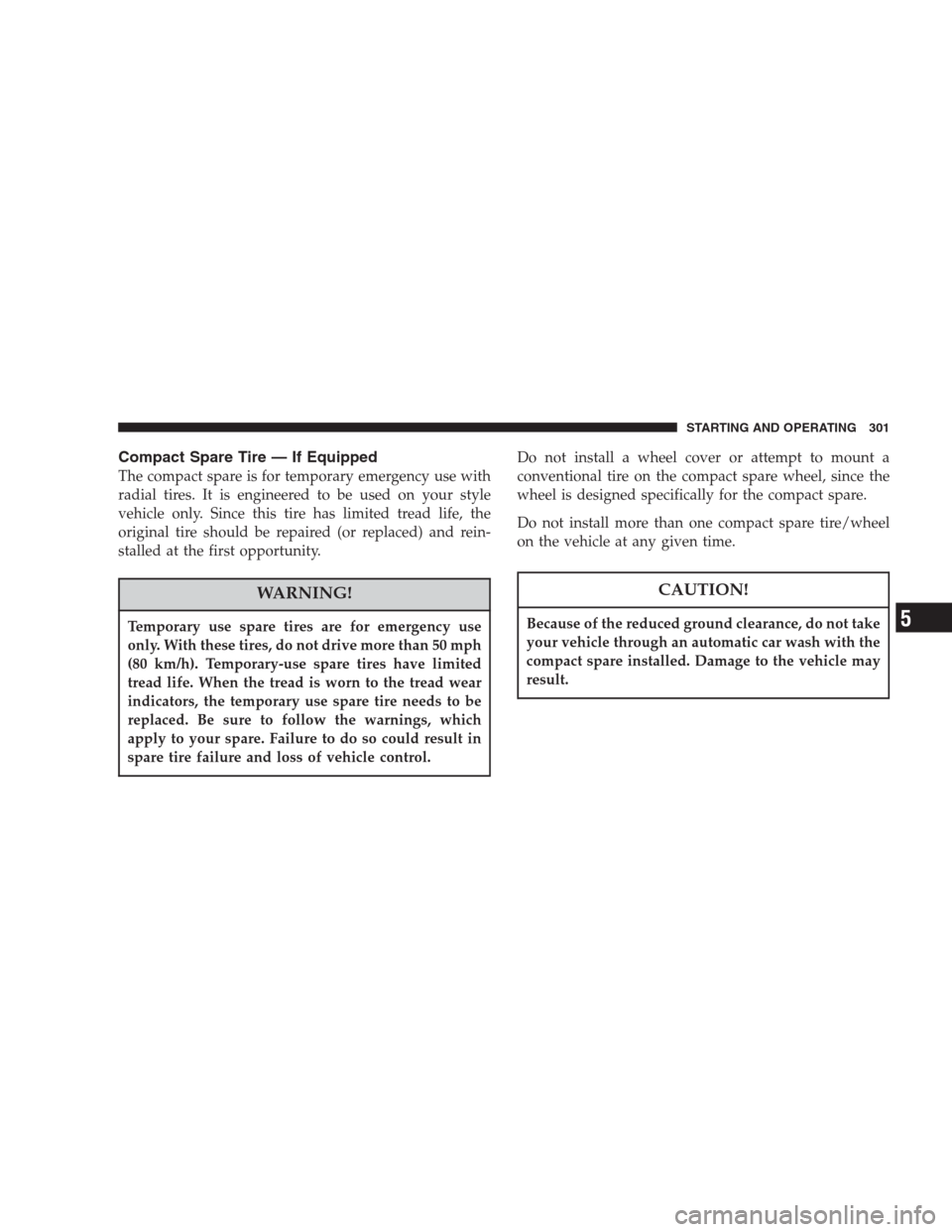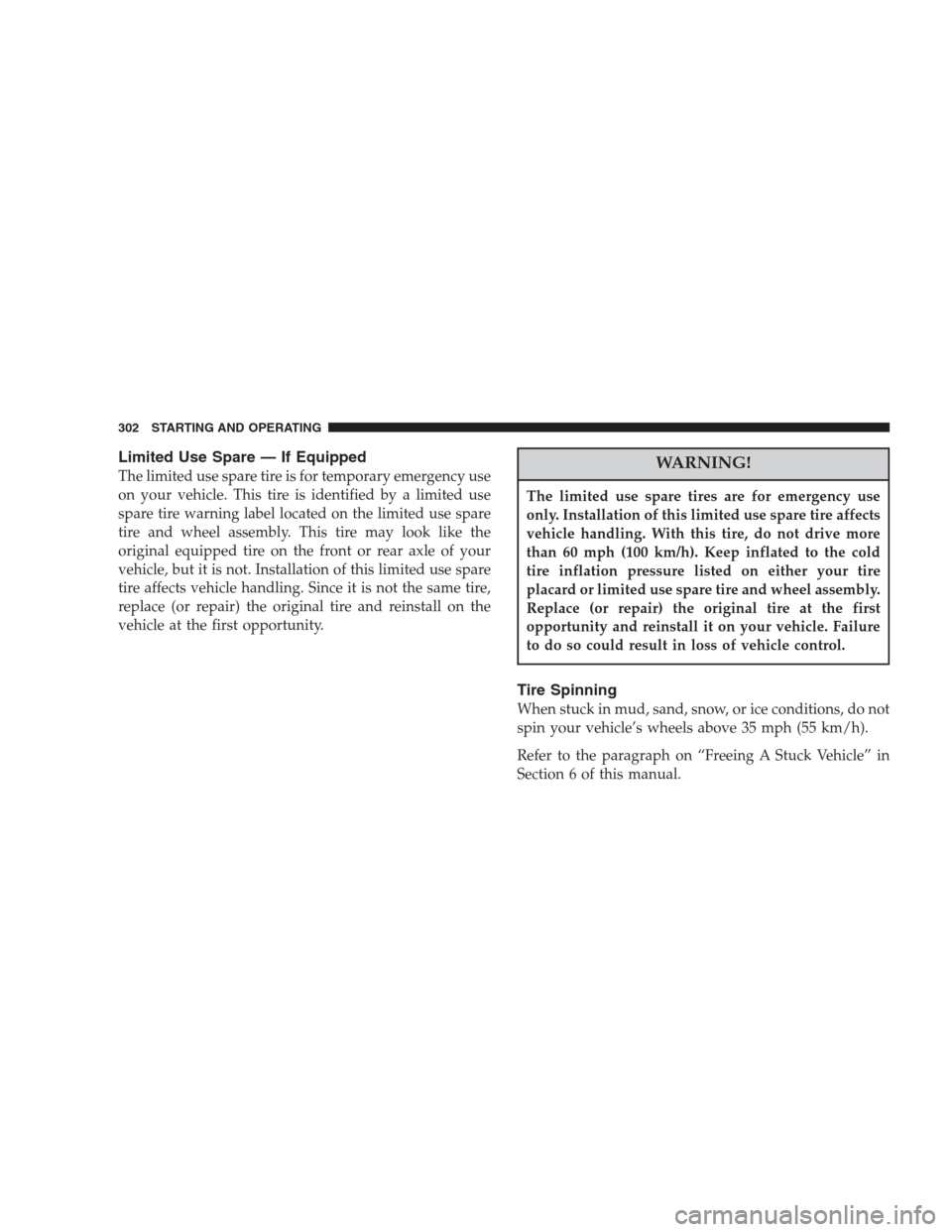2007 CHRYSLER PACIFICA spare wheel
[x] Cancel search: spare wheelPage 81 of 464

Periodic Safety Checks You Should Make Outside
The Vehicle
Tires
Examine tires for excessive tread wear or uneven wear
patterns. Check for stones, nails, glass, or other objects
lodged in the tread. Inspect tread and sidewall for cuts or
cracks. Check wheel nuts for tightness, and tires (includ-
ing spare) for proper pressure.
Lights
Have someone observe the operation of exterior lights
while you work the controls. Check turn signal and high
beam indicator lights on the instrument panel.
Fluid Leaks
Check area under vehicle after overnight parking for fuel,
engine coolant, oil or other fluid leaks. Also, if gasoline
fumes are detected or fuel, power steering fluid, trans-
mission fluid or brake fluid leaks are suspected, the cause
should be located and corrected immediately.
THINGS TO KNOW BEFORE STARTING YOUR VEHICLE 81
2
Page 301 of 464

Compact Spare Tire — If Equipped
The compact spare is for temporary emergency use with
radial tires. It is engineered to be used on your style
vehicle only. Since this tire has limited tread life, the
original tire should be repaired (or replaced) and rein-
stalled at the first opportunity.
WARNING!
Temporary use spare tires are for emergency use
only. With these tires, do not drive more than 50 mph
(80 km/h). Temporary-use spare tires have limited
tread life. When the tread is worn to the tread wear
indicators, the temporary use spare tire needs to be
replaced. Be sure to follow the warnings, which
apply to your spare. Failure to do so could result in
spare tire failure and loss of vehicle control.
Do not install a wheel cover or attempt to mount a
conventional tire on the compact spare wheel, since the
wheel is designed specifically for the compact spare.
Do not install more than one compact spare tire/wheel
on the vehicle at any given time.
CAUTION!
Because of the reduced ground clearance, do not take
your vehicle through an automatic car wash with the
compact spare installed. Damage to the vehicle may
result.
STARTING AND OPERATING 301
5
Page 302 of 464

Limited Use Spare — If Equipped
The limited use spare tire is for temporary emergency use
on your vehicle. This tire is identified by a limited use
spare tire warning label located on the limited use spare
tire and wheel assembly. This tire may look like the
original equipped tire on the front or rear axle of your
vehicle, but it is not. Installation of this limited use spare
tire affects vehicle handling. Since it is not the same tire,
replace (or repair) the original tire and reinstall on the
vehicle at the first opportunity.WARNING!
The limited use spare tires are for emergency use
only. Installation of this limited use spare tire affects
vehicle handling. With this tire, do not drive more
than 60 mph (100 km/h). Keep inflated to the cold
tire inflation pressure listed on either your tire
placard or limited use spare tire and wheel assembly.
Replace (or repair) the original tire at the first
opportunity and reinstall it on your vehicle. Failure
to do so could result in loss of vehicle control.
Tire Spinning
When stuck in mud, sand, snow, or ice conditions, do not
spin your vehicle’s wheels above 35 mph (55 km/h).
Refer to the paragraph on “Freeing A Stuck Vehicle” in
Section 6 of this manual.
302 STARTING AND OPERATING
Page 306 of 464

Improper alignment will not cause vehicle vibration.
Vibration may be a result of tire and wheel out-of-
balance. Proper balancing will reduce vibration and
avoid tire cupping and spotty wear.
TIRE CHAINS
Use only compact chains, or other traction aids that meet
SAE type “Class S” specifications. Chains must be the
proper size for the vehicle, as recommended by the chain
manufacturer.
NOTE:Do not use tire chains on a compact spare tire.
CAUTION!
To avoid damage to your vehicle or tires, observe the following
precautions:
•Because of restricted chain clearance between tires and other
suspension components, it is important that only chains in
good condition are used. Broken chains can cause serious
damage. Stop the vehicle immediately if noise occurs that
could indicate chain breakage. Remove the damaged parts of
the chain before further use.
•Install chains on the front wheels as tightly as possible and
then retighten after driving about1�2mile (0.8 km).
•Do not exceed 45 mph (70 km/h).
•Drive cautiously and avoid severe turns and large bumps,
especially with a loaded vehicle.
•If chains are used on an All Wheel Drive (AWD) vehicle, they
should be used on all four tires.
•Do not drive for prolonged period on dry pavement.
•Observe the tire chain manufacturer’s instructions on the
method of installation, operating speed, and conditions for
use. Always use the lower suggested operating speed of the
chain manufacturer if different than the speed recommended
by the manufacture.
306 STARTING AND OPERATING
Page 309 of 464

•The Tire Pressure Monitoring System (TPMS) will
warn the driver of a low tire pressure if the tire
pressure falls below the low pressure warning thresh-
old for any reason, including low temperature effects.
•The Tire Pressure Monitoring System (TPMS) will
continue to warn the driver of low tire pressure as long
as the condition exists, and will not turn off until the
tire pressure is at or above recommended cold placard
pressure. Once the low tire pressure warning telltale
has been illuminated, the tire pressure must be in-
creased to the recommended cold placard pressure in
order for the Tire Pressure Monitoring System warning
telltale to be turned off. The system will automatically
update and the Tire Pressure Monitoring System
warning telltale will extinguish once the updated tire
pressures have been received.
NOTE:
The vehicle may need to be driven for up to 10
minutes above 15 mph (25 km/h) to receive this information.
Tire Pressure Monitoring Base System without
Electronic Vehicle Information Center (EVIC) — If
Equipped
The Tire Pressure Monitor System (TPMS) uses wireless
technology with wheel rim mounted electronic sensors to
monitor tire pressure levels (EXCLUDING THE SPARE
TIRE). Sensors, mounted to each wheel as part of the
valve stem, transmit tire pressure readings to the Re-
ceiver Module.
NOTE:It is particularly important, for you to check the
tire pressure in all of your tires regularly and too main-
tain the proper pressure.
The Tire Pressure Monitor System (TPMS) consists of the
following components:
•Receiver Module
•4 Wheel Sensors
•Tire Pressure Monitoring Telltale Lamp
STARTING AND OPERATING 309
5
Page 310 of 464

Tire Pressure Monitoring Low Pressure Warnings
The Tire Pressure Monitoring Telltale Lamp
will illuminate in the instrument cluster and an
audible chime will be activated when one or
more of the four active road tire pressures are
low. The audible chime will sound once every ignition
cycle for each low tire condition that it detects.
Should this occur you should stop as soon as possible,
check the inflation pressure of each tire on your vehicle,
and inflate each tire to the pressure recommended by the
vehicle tire pressure placard. The system will automati-
cally update and the Tire Pressure Monitoring System
Lamp will extinguish once the updated tire pressure(s)
have been received.
NOTE:The vehicle may need to be driven for up to 10
minutes above 15 mph (25 km/h) to receive this infor-
mation.NOTE:A low spare or compact tire pressure will not
cause the Tire Pressure Monitoring System Telltale Lamp
to illuminate or the chime to sound.
Base Tire Pressure Monitoring System with
Electronic Vehicle Information Center (EVIC) — If
Equipped
The Tire Pressure Monitor System (TPMS) uses wireless
technology with wheel rim mounted electronic sensors to
monitor tire pressure levels (EXCLUDING THE SPARE
TIRE). Sensors, mounted to each wheel as part of the
valve stem, transmit tire pressure readings to the Re-
ceiver Module.
NOTE:It is particularly important, for you to check the
tire pressure in all of your tires regularly and too main-
tain the proper pressure.
310 STARTING AND OPERATING
Page 312 of 464

Service Tire System Soon
The Tire Pressure Monitoring Telltale Lamp will flash on
and off for 60 seconds in the instrument cluster, and an
audible chime will be activated when one or more of the
four active road tire pressures are low.
In addition the Electronic Vehicle Information Center
(EVIC) will display a“SERVICE TIRE SYSTEM SOON”
text message. The flash cycle will repeat every ten
minutes, without an audible chime, until the condition no
longer exists. The flash cycle sequence will repeat and an
audible chime will sound once every ignition cycle for
each condition that it detects.
NOTE:If a temporary spare tire is in use and none of
the remaining 3 active road tire pressures are low, a
“SERVICE TIRE SYSTEM SOONtextual message will
appear in the EVIC after 10 minutes of driving,CAUTION!
The Tire Pressure Monitoring System has been op-
timized for the original equipment tires and wheels.
TPMS pressures have been established for the tire
size equipped on your vehicle. Undesirable system
operation or sensor damage may result when using
replacement equipment that is not of the same size,
type, and/or style. After-market wheels can cause
sensor damage. Do not use tire sealant from a can, or
balance beads if your vehicle is equipped with a
TPM System, as damage to the sensors may result.
312 STARTING AND OPERATING
Page 313 of 464

CAUTION!
After inspecting or adjusting the tire pressure al-
ways reinstall the valve stem cap. This will prevent
moisture and dirt from entering the valve stem,
which could damage the wheel rim sensor.
NOTE:
•The Tire Pressure Monitoring System does not monitor
the temporary spare tire.
•The TPMS is not intended to replace normal tire care
and maintenance, or to provide warning of a tire
failure or condition.
•The TPMS should not be used as a tire pressure gauge
while adjusting your tire pressure.
•Driving on a significantly underinflated tire causes the
tire to overheat and can lead to tire failure. Underin-
flation also reduces fuel efficiency and tire tread life,
and may affect the vehicle’s handling and stopping
ability.
•The TPMS is not a substitute for proper tire mainte-
nance, and it is the driver ’s responsibility to maintain
correct tire pressure, even if under-inflation has not
reached the level to trigger illumination of the Tire
Pressure Monitoring Telltale Lamp.
Using Your Compact Spare — Basic Tire
Pressure Monitoring System Only
Your vehicle is equipped with a compact spare wheel and
tire assembly that does not have a tire pressure monitor-
ing sensor. Therefore, it will not be monitored by the Tire
Pressure Monitoring System. In the event that a compact
spare tire is used to replace a low pressure road tire, the
next ignition key cycle will still show the Tire Pressure
STARTING AND OPERATING 313
5